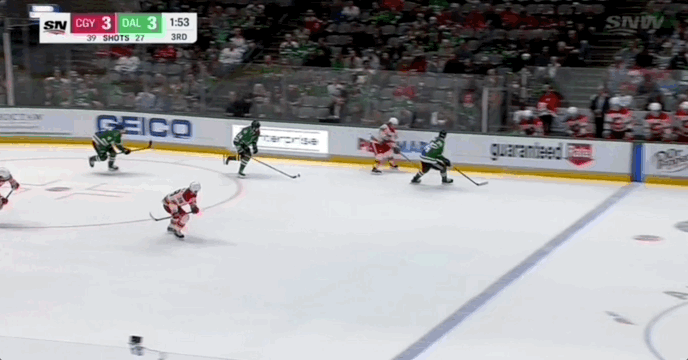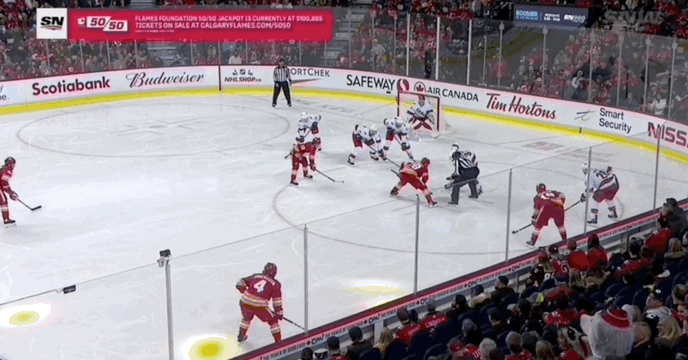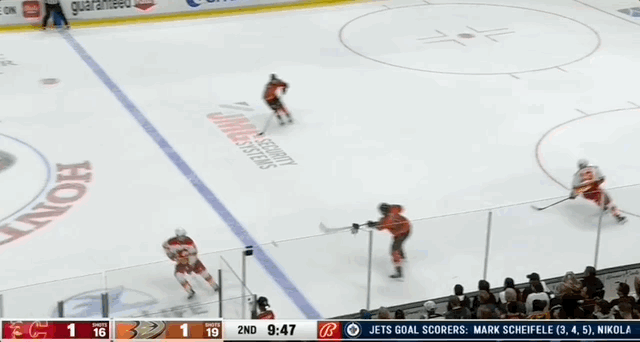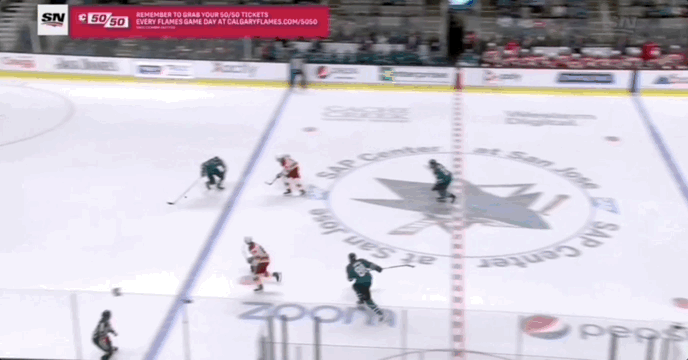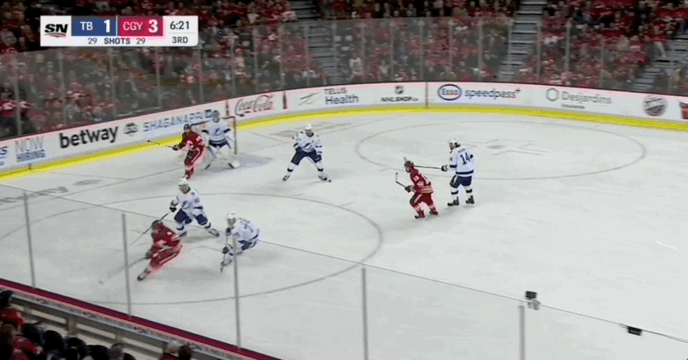Elias Lindholm’s already set a career high in goal scoring this season with 38 in 71 games that exceeds his prior best, 29 in 70 games played in the condensed 2019-20 season.
It’s easy to focus on his shot since the actual goal is often the most memorable part of a scoring play.
Lindholm’s found a ton of success by getting to the slot, where most of his goals have come from.
It helps that he’s playing alongside an MVP-calibre teammate in Johnny Gaudreau to often set him up. The left wing has 25 assists on Lindholm's goals, 14 of which are primary. And Lindholm's right-wing is no pushover, either. At 5-on-5, he’s played almost exclusively with Gaudreau and Matthew Tkachuk; they’re the most consistent forward combination in the league, leading the way with their 830-plus minutes together.
But what about how Lindholm helps set up his teammates?
Lindholm’s scoring only slightly slants towards goals; of his 73 points, 35 are helpers. The knock on him, compared to his two linemates, is that he directly contributes to offence the least based on his primary point percentage. Fifteen of those assists are secondary. Still, the centre’s two-way plays often facilitate scoring sequences, even when he doesn’t get on the scoresheet, and that’s what makes him such a complementary part of the combination.
So let’s take a closer look at how Lindholm contributes to scoring plays aside from that shot.
Starting back in the defensive zone, Lindholm shows that he isn’t just a one-dimensional player who goes into a shell in an attempt to just absorb his opponents’ chances. Rather, he finds ways to gain the puck back so he, and his teammates, can move it up the ice.
There are two key ways he gains possession: intercepts and puck retrievals. He can recover loose pucks after rebounds or battle along the boards for it; Lindholm leads the forward group at contested retrievals back in his own end.
Or, he can intercept his opponents’ attempts to move the puck which is how he earned his lone even strength secondary assist from the defensive end. Lindholm leads the Flames’ forwards in blocked passes in the defensive zone with 6.06 per 60. It highlights the centre’s ability to read opponents’ plays, and in this case, how it can help generate offence.
In this sequence specifically, it’s the least memorable part of the play: Gaudreau’s flip pass and Tyler Toffoli’s score are rightfully the standouts. But it’s a smart move from Lindholm that helped spark it in the first place by gaining possession.
Lindholm, along with plays to gain the puck, can help move it up the ice as well. The Flames’ 1C isn’t nearly the transitional star that his winger Gaudreau is, one of the best in the league at skating the puck up the ice, and creating offence off the rush. But Lindholm can contribute to that with an outlet pass to break the puck out of the defensive end at a higher rate than most of his forward teammates.
All three of his primary assists in the defensive zone, and a couple in the neutral zone, led to empty-net goals. At minimum, Lindholm's usage in those situations — defensive zone play (and face-off draws) while out-manned — shows a trust from his coaches in those key moments of a game defending a lead.
For the most part, the rest of those neutral zone assists help lead to chances off the rush. At 5-on-5, the Flames are the fifth best team at generating slot shots and goals off the rush. Both Tkachuk and Gaudreau are key components of that.
The majority of Lindholm’s assists, unsurprisingly, come from the offensive zone. Sometimes those scores come from skillful passing plays, like this clutch goal against the Stars.
Other instances include his efforts at the dot, and scoring plays that immediately follow. These plays are important, because there can be a spike in net shots within those first 10 seconds after an offensive zone draw. That puts an emphasis on winning a clean face-off and finding a way to make that quick impact.
But similar to the other end of the ice, it’s how Lindholm can prevent his opponents' puck receptions that are particularly important; that’s something he leads his teammates at in Calgary in all three zones.
Lindholm can block opponents’ pass attempts as they try to leave their own zone. Or, he can jump on any bobbled pucks to force plays and stay deep. Take the clip below versus Anaheim: seeing as Lindholm’s the goal scorer, there’s no earned assist here, but he's the player to start the sequence.
And there’s Lindholm’s knack for winning puck battles, even when under pressure. These plays, on quite a few occasions, pull defenders to him and buy his teammates some space to get in position. Once he retrieves or digs the puck, he can quickly move it to an open winger he spots waiting in higher danger areas.
One of the common threads with these contested puck retrievals that lead to goals is how often it takes place behind the net. That’s even more beneficial. It usually brings multiple opponents below the end line to increase their chances of coming away with possession — take the three Sharks that are drawn in ahead of the scoring play below. If these skaters fail and Lindholm can make the quick pass, the defenders probably won’t be able to get back to stop a shot attempt.
Adding another wrinkle is the challenge of a goaltender reading passes that come from behind the net — which as the viz above shows are where Lindholm’s earned a few assists this season. Passes that come from behind the net and directly precede shots take away a goalies eyes and their ability to anticipate where the puck is going. With quick movement, there’s little to no time for a goalie to react.
Put together Lindholm’s ability to win those puck battles plus a behind-the-net pass (this time courtesy of Gaudreau), and there’s the pivot’s tying goal against the Kings earlier this week.
Lindholm’s two-way efforts are felt in all situations, in all three zones. In a small scale, it can be as simple as limiting a scoring chance against by closing passing lanes. Or, it can be a pass to set up a linemate on the other end of the ice. But often times, it’s facilitating plays that help the Flames gain (and maintain) possession — whether that leads to sustained pressure or a goal.
The centre has consistently contributed directly, or indirectly, to scoring plays that have been pivotal to Calgary’s success all season.
Data via Sportlogiq




